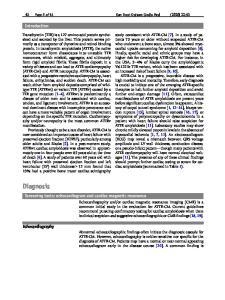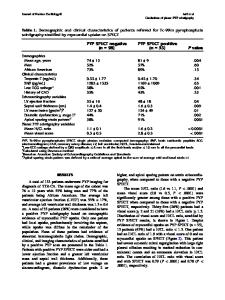Avoiding misdiagnosis: expert consensus recommendations for the suspicion and diagnosis of transthyretin amyloidosis for
- PDF / 1,485,277 Bytes
- 12 Pages / 595.276 x 790.866 pts Page_size
- 26 Downloads / 258 Views
GUIDELINES
Open Access
Avoiding misdiagnosis: expert consensus recommendations for the suspicion and diagnosis of transthyretin amyloidosis for the general practitioner Morie Gertz1* , David Adams2, Yukio Ando3, João Melo Beirão4, Sabahat Bokhari5, Teresa Coelho6, Raymond L. Comenzo7, Thibaud Damy8, Sharmila Dorbala9, Brian M. Drachman10, Marianna Fontana11, Julian D. Gillmore11, Martha Grogan1, Philip N. Hawkins11, Isabelle Lousada12, Arnt V. Kristen13, Frederick L. Ruberg14, Ole B. Suhr15, Mathew S. Maurer5, Jose Nativi-Nicolau16, Candida Cristina Quarta11, Claudio Rapezzi17, Ronald Witteles18 and Giampaolo Merlini19,20
Abstract Background: Transthyretin amyloidosis (also known as ATTR amyloidosis) is a systemic, life-threatening disease characterized by transthyretin (TTR) fibril deposition in organs and tissue. A definitive diagnosis of ATTR amyloidosis is often a challenge, in large part because of its heterogeneous presentation. Although ATTR amyloidosis was previously considered untreatable, disease-modifying therapies for the treatment of this disease have recently become available. This article aims to raise awareness of the initial symptoms of ATTR amyloidosis among general practitioners to facilitate identification of a patient with suspicious signs and symptoms. Methods: These consensus recommendations for the suspicion and diagnosis of ATTR amyloidosis were developed through a series of development and review cycles by an international working group comprising key amyloidosis specialists. This working group met to discuss the barriers to early and accurate diagnosis of ATTR amyloidosis and develop a consensus recommendation through a thorough search of the literature performed using PubMed Central. Results: The cardiac and peripheral nervous systems are most frequently involved in ATTR amyloidosis; however, many patients often also experience gastrointestinal and other systemic manifestations. Given the multisystemic nature of symptoms, ATTR amyloidosis is often misdiagnosed as a more common disorder, leading to significant delays in the initiation of treatment. Although histologic evaluation has been the gold standard to confirm ATTR amyloidosis, a range of tools are available that can facilitate early and accurate diagnosis. Of importance, genetic testing should be considered early in the evaluation of a patient with unexplained peripheral neuropathy. (Continued on next page)
* Correspondence: [email protected] 1 Mayo Clinic, 200 First Street SW, Rochester, MN 55905, USA Full list of author information is available at the end of the article © The Author(s). 2020 Open Access This article is licensed under a Creative Commons Attribution 4.0 International License, which permits use, sharing, adaptation, distribution and reproduction in any medium or format, as long as you give appropriate credit to the original author(s) and the source, provide a link to the Creative Commons licence, and indicate if changes were made. The images or other third party material in this article are included in the ar
Data Loading...











